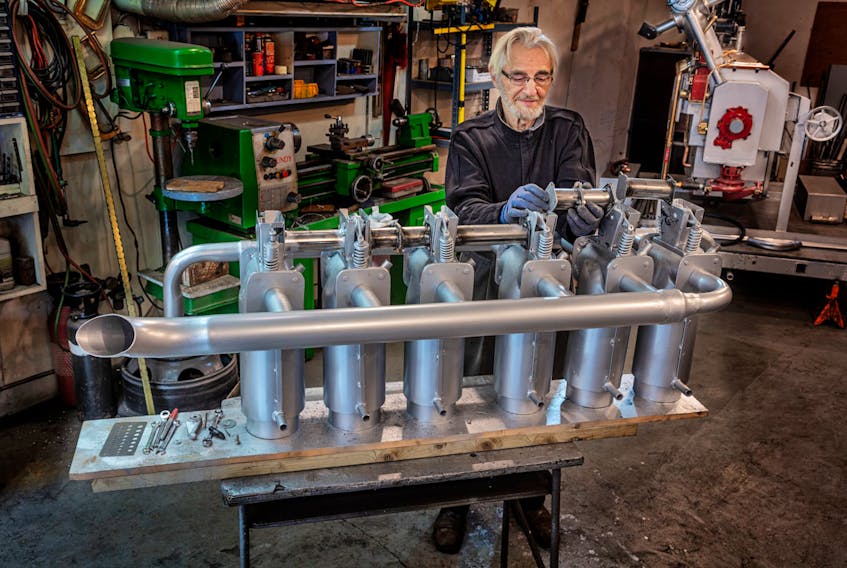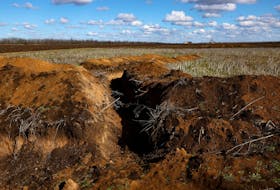PARRSBORO, N.S. — It’s a noise that woke many in Parrsboro in the early morning hours of July 5, 1919.
Some feared an air raid, even though the First World War had been over for nearly a year, while others at first thought it was a UFO. Instead, it was a massive Handley Page Atlantic four-engine bomber en route from the colony of Newfoundland to the United States – and it was in trouble.
Kerwin Davison, who is a member of the Parrsborough Shore Historical Society, has long been fascinated about the stories that have been passed down through time about the emergency landing.
With the 100th anniversary of that event approaching, he decided he wanted to use his talents to help commemorate the event.
Since last September, the 86-year-old Parrsboro resident has been building a model of an engine that would’ve been used by the aircraft that was designed and built as a First World War bomber that never entered service before the war ended in November 1918.
“We’re doing the 100-year commemoration this summer and I thought it would be a great idea to build one of the four Rolls Royce engines that would’ve been on that aircraft,” Davison said.
It was very early on a July morning in 1919 when many Parrsboro resident were awoken by the sound of a four-engine bomber circling the area.
“The bomber had four massive engines and one of them got into difficulty, so they had to find a place to land,” Davison said. “Some reports indicate it blew a piston through a wall. There were also reports of an oil leak. The fact is it flew into Cape Breton and ran into a high head wind and were getting low on fuel. They had a problem on their hands.”
The plane continued along the natural flight path from Point A to B. The flight crew saw the lights of Parrsboro, which in 1919 was one of the few communities in the area with electric power.
“They came in sometime around 5 a.m., circled between Port Greville and Economy. It woke everyone up because you can just imagine what the sound of four V12 Rolls Royce engines without mufflers would make,” Davison said. “The locals with their Model Ts all went out to the racetrack to light up a landing strip. It was the only flat piece of land without any trees.”
Davison said people didn’t know what to think of the giant airplane with some thinking it might have been a UFO.
The plane circled til daylight before landing on the makeshift runway just off Western Avenue. However, before it could come to a complete stop it hit a barbed wire fence that caused extensive damage to the aircraft.
The plane would remain in Parrsboro for four months before it was able to continue its journey to New York on Oct. 9, 1919. It would carry the first airmail between Canada and the United States.
Davison’s idea started with nothing more than a photo of a Rolls Royce engine. He studied the engine’s design, made sketches outlining his plan, while collecting the materials he would need to build a replica of the 375-horsepower engine.
The engine parts included magnetos from an antique Hart-Parr tractor, the bellhousing from an International truck, North American Zenith carburetors as well as fittings saved from his years in the heating business.
If he couldn’t find the parts, Davison, who is a member of the Parrsborough Shore Historical Society that runs Ottawa House Museum, made them himself.
Construction began when his friends at Granby Furnace cut and bent the steel chassis and rolled the steel for the engine’s 12 cylinders.
Working out his Greenhill workshop near Parrsboro, Davison would go to work on his project at 5 a.m., taking a break at 10 a.m. to have coffee with his wife, Anne.
Dedicating at least five hours a day, many times seven days a week, Davison is getting near the end of the project that when completed will be encased in heavy glass with an accessible control panel that will allow people to see the wooden propeller spin and hear a simulated engine roar.
It will be unveiled during a ceremony this summer at the Parrsboro Band Stand during the community’s Old Home Week Parade.
Another project to commemorate the emergency landing is the construction of 1/18th scale model of the bomber by John Meadows of Parrsboro and Garry Stern of Salisbury, N.B.
The replica of what was the world’s largest plane in 1919 will be on display in Parrsboro this summer.
Numerous events are being planned throughout the summer to commemorate the event.
Ottawa House Museum will also be selling copies of a 60-page history, Time Flies 1919-2019: Memories of the Handley Page Atlantic, compiled by Gale Boland.









